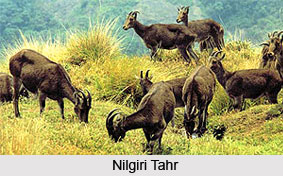 Among the handful of national parks that are prevalent in this part of India, Eravikulam National park is one of the most significant one. Eravikulam National Park is located in the Indian state of Kerala. More specifically, this national park is situated in the Idukki district, along the Western Ghats. The administration of this park is handled by the Kerala Department of Forests and Wildlife, Munnar Wildlife Division, together with the nearby Mathikettan Shola National Park, Anamudi Shola National Park, Pambadum Shola National Park, Chinnar Wildlife Sanctuary and the Kurinjimala Sanctuary. This national park is credited with the status of being the first national park in Kerala and a UNESCO (United Nations Educational, Scientific and Cultural Organization) World Heritage Site.
Among the handful of national parks that are prevalent in this part of India, Eravikulam National park is one of the most significant one. Eravikulam National Park is located in the Indian state of Kerala. More specifically, this national park is situated in the Idukki district, along the Western Ghats. The administration of this park is handled by the Kerala Department of Forests and Wildlife, Munnar Wildlife Division, together with the nearby Mathikettan Shola National Park, Anamudi Shola National Park, Pambadum Shola National Park, Chinnar Wildlife Sanctuary and the Kurinjimala Sanctuary. This national park is credited with the status of being the first national park in Kerala and a UNESCO (United Nations Educational, Scientific and Cultural Organization) World Heritage Site.
History of Eravikulam National Park
The story of the formation of Eravikulam National Park deserves mentioning. Previously, it was a `game-hunting` ground, popularly known as Hamilton`s Plateau. In the late years of the nineteenth century, the North Travancore Land Planting Society owned up a large portion of this region. It was discovered that the region was not at all suitable for tea plantations and so, much later the Kannan Dcvan Hill Produce Corporation undertook the grave responsibility of managing it as a personal hunting reserve. In the succeeding years of 1895, the High Range Game Preservation Association assured the protection and preservation of much of this abundant wild habitation. Then, it was only recently in the year 1975, when the Kerala Government acknowledged it as a wildlife sanctuary. After three years, i.e. in the year 1978, it was promoted to the status of national park, with it"s plethora of wild life and biodiversities being highly acknowledgeable.
Geography of Eravikulam National Park
Globally, Eravikulam National Park can be pinpointed at coordinates 10 degrees 12 minutes 00 seconds north and 77 degrees 04 minutes 59 seconds east. This national park is spread over an area of about 97 square kilometers. The park area is classified into three major parts namely, the core area, the buffer area and the tourism area. This national park is located at an elevation of about 7000 feat above the sea level. This park has the highest peak of India called the Anamudi (2,695 meters) which is located south of the Himalayas. The main part of the park consists of a high rolling hill plateau with a base elevation of about 2,000 m. Many perennial streams also traverse this park. They amalgamate to form the tributaries of the River Periyar in the west and of the River Cauvery in the east. Another geographical feature located within the park is Lakkom Water Falls.
Flora of Eravikulam National Park
Eravikulam National Park is a home to three major types of plant communities namely, grasslands, shrub lands and forests. High altitude grasslands intersperse with the Sholas. The forests in this park are commonly known as "shoals". Shoals are evergreen tropical and sub tropical moist broadleaf forests. There are innumerable small patches of forests in the hollows and gullies of the park areas. The park also has forested deeper valleys. The bases of the cliffs in the park are dominated by shrub lands. This park houses an antibacterial called eupatorium glandulosum.
Fauna of Eravikulam National Park
Eravikulam National Park provides shelter to about 19 species of amphibians and about 26 species of mammals. A noteworthy example of mammal housed in the park is the largest surviving population of Nilgiri Tahr. Some of the other species are golden jackal, gaur, dhole and sambar deer. 
Avifauna of Eravikulam National Park
Eravikulam National Park is a home to about 132 species of birds. Some of them are endemics like black-and-orange flycatcher, Nilgiri pipit, white bellied short-wing and Nilgiri wood pigeon.
Tourism of Eravikulam National Park
The tourism area of Eravikulam National Park is called Rajamalai. The forest authorities are responsible for the tour to Rajamalai. It is recommended to visit Rajamalai on foot. Tourists are also provided with the opportunity to experience the forest on their own. Tourists can experience the shoal grassland ecosystem, traversing deep inside the forest of the area. The Nilgiri Tahr located nearby can also be viewed by the tourists. This park therefore undoubtedly serves as a tourism product of Kerala.
Visiting Information
Nearest airport to Eravikulam National Park is in Madurai (Tamil Nadu). This airport is located at a distance of about 142 km from the national park. Another airport near Eravikulam is Cochin International Airport. This airport is located at a distance of about 150 km from the national park. Nearest railway station to Eravikulam National Park is in Aluva. This railway station is located at a distance of about 109 km from Munnar. Another railway station near Eravikulam is in Angamali. This railway station is located at a distance of about 108 km from Munnar.
Related Articles:
Indian National Parks
Indian Wildlife Sanctuaries
Indian Flora and Fauna
Indian Wildlife
Bird Sanctuaries in India
Indian Biosphere Reserves











